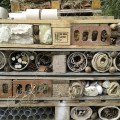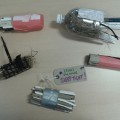Lots of minibeasts (invertebrates) love our gardens, including useful and attractive species like ladybirds. One way we can encourage minibeasts to visit, or to stay a bit longer is to make a safe place for them to spend the colder winter. You can download a copy of this information here.
Compost heaps and piles of logs are the kind of natural places they like to stay, they love to crawl in between sticks and twigs where it is warmer and sheltered. Making your own minibeast hibernation home will provide additional places for them to stay, it’s great fun too.

 Your hibernation home can be as large or as small as you like, just make sure you have lots of little spaces for the minibeasts to crawl into.
Your hibernation home can be as large or as small as you like, just make sure you have lots of little spaces for the minibeasts to crawl into.
Minibeasts have their own special requirements when looking for a home so if you can use different materials you will attract different insects. Here are some suggestions –
- Straw or wood is loved by pretty lacewings, whose larvae feed on many pests: aphids, obscure mealy bugs, whiteflies, thrips or eggs of acari. Also great for other burrowing insects.
- Bamboo rods and drilled logs provide shelter for solitary bees and wasps like the mason bee, that pollinate the first flowers of fruit trees and whose larvae feed on aphids.
- Flower pots filled with hay attract earwigs who also feed on pests. An upside down flower pot might also attract a queen bee.
- Wooden boards will attract xylophagous insects involved in the decomposition of dead wood.
- Bundles of pith rods such as the bramble, rose, elderberry, provide shelter ideal for hoverflies and other Hymenoptera.
- Bricks, stones and roof tiles would be appreciated by amphibians such as frogs and newts that will rest and hibernate amongst damp bases.
- Ladybirds like to hibernate in nooks and crannies in dead wood and under bark. Their larvae consume a lot of aphids.
- Nectar rich potted plants close by might also attract bees and butterflies.
For best results, put your hibernation home on the ground in a fairly dry, sheltered place near some vegetation, like the bottom of a hedge during the autumn. Hang, or place your insect house in a warm sunny position with the end pointing down slightly to let moisture out. Invertebrates should hopefully move in and will emerge again in the spring.
If you are curious, in the spring gently tap the end of the tube onto a sheet of white paper to see what is inside. Be gentle with anything you find and make sure you return the creatures to the place you find them though!
